Understanding Flashover:
Myths & Misconceptions Part 2
A Quick Review
The first post in this series, Understanding Flashover: Myths & Misconceptions provided a definition of flashover and examined this extreme fire behavior phenomenon in the context of fire development in a compartment.
Flashover is the sudden transition to fully developed fire. This phenomenon involves a rapid transition to a state of total surface involvement of all combustible material within the compartment….Flashover may occur as the fire develops in a compartment or additional air is provided to a ventilation-controlled fire (that has insufficient fuel in the gas phase and/or temperature to backdraft).
Burning Regime
In the incipient and early growth stages of a compartment fire, the speed of fire growth is fuel controlled as fire development substantially influenced by the chemical and physical characteristics of the fuel. However, oxygen is required for the fuel to burn and release thermal energy. As a compartment fire develops, the available air supply for combustion becomes a more important factor. Increased combustion requires more oxygen and as smoke fills the compartment while the lowering neutral plane at compartment openings restricts the introduction of air into the compartment (see Figure 1).
The neutral plane is the level at a compartment opening where the difference in pressure exerted by expansion and buoyancy of hot smoke flowing out of the opening and the inward pressure of cooler, ambient temperature air flowing in through the opening is equal (Karlsson & Quintiere, 2000).
Figure 1. Lowering Neutral Plane
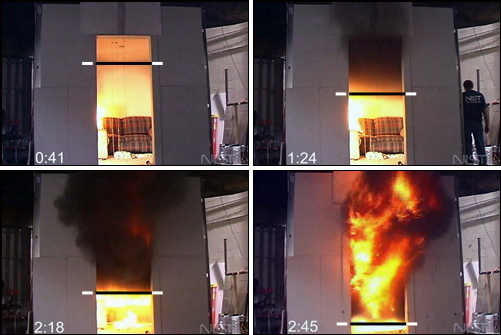
Note: Photos adapted from National Institute of Standards and Technology (NIST) ISO-Room/Living Room Flashover.
The distinction between fuel controlled and ventilation controlled is critical to understanding compartment fire behavior. Compartment fires are generally fuel controlled while in the incipient and early growth stage and again as the fire decays and the demand for oxygen is reduced (see Figure 2).
Figure 3. Fire Development with Limited Ventilation
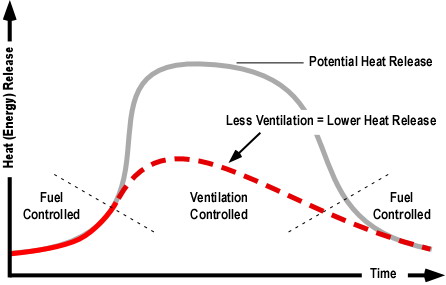
While a fire is fuel controlled, the rate of heat release and speed of development is limited by fuel characteristics as air within the compartment and the existing ventilation profile provide sufficient oxygen for fire development. However, as the fire grows the demand for oxygen increases, and at some point (based on the vent profile) will exceed what is available. At this point the fire transitions to ventilation control. As illustrated in Figure 1, a ventilation controlled fire may reach flashover, all that is necessary is that sufficient oxygen be available for the fire to achieve a sufficient heat release rate for flashover to occur.
Heat Release and Oxygen
Combustion, as an oxidation reaction requires sufficient oxygen to react with the available fuel. Heat of combustion (energy released) and oxygen required for complete combustion are directly related (Thornton, 1917).The energy released per gram of oxygen consumed during complete combustion of natural and synthetic organic fuels is fairly consistent, averaging 13.1 kJ/g (±0.5%) (Huggett, 1980).
Release of chemical potential energy from fuel is dependent on availability of adequate oxygen for the combustion reaction to occur. Interestingly, while the heat of combustion of various types of organic (carbon based) fuel varies widely, the amount of oxygen required for release of a given amount of energy remains remarkably consistent.
In the early 1900s, British scientist W.M. Thornton (1917) discovered that the amount of oxygen required per unit of energy released from many common hydrocarbons and hydrocarbon derivatives is fairly constant. In the 1970’s, researchers at the National Bureau of Standards independently discovered the same thing and extended this work to include many other types of organic materials and examined both complete and incomplete combustion (Huggett, 1980; Parker, 1977).
Each kilogram of oxygen used in the combustion of common organic materials results in release of 13.1 MJ of energy. This is referred to as Thornton’s Rule. See Fuel and Ventilation for a more detailed discussion of the application of Thornton’s Rule to compartment fires and ventilation.
Failure to Reach Flashover
Ventilation controlled compartment fires may reach flashover and fully developed compartment fires are generally ventilation controlled (IAAI, 2009). However, lack of ventilation may prevent a compartment fire from generating sufficient heat release rate to reach flashover. In some cases, ventilation controlled fires to not become fully developed, but decay and self-extinguish due to lack of oxygen.
In late 2007 an engine and truck company responded to a report of an odor of smoke in a three-story, wood-frame, apartment building. They discovered a ground floor apartment was smoke logged. They requested a first alarm assignment, forced entry, and initiated fire attack and primary search. Smoke was cool and to the floor, the fire was confined to an upholstered chair and miscellaneous items in the living room and at the time of entry was simply smoldering (see Figure 3). A rapid search discovered a deceased occupant in a bedroom remote from the fire.
Figure 3. Self-Extinguished Compartment Fire
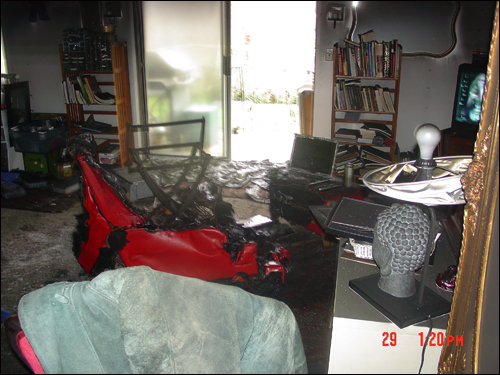
Note: Gresham Fire & Emergency Services Photo
While a fire involving an upholstered chair typically results in sufficient heat release rate for the fire to extend to other nearby fuel packages and ultimately reach flashover, this fire did not as evidenced by the condition of the Christmas tree on the opposite side of the living room from the point of origin (see Figure 4). The Christmas tree, like many other fuel packages in the apartment showed evidence of pyrolysis, but did not ignite.
Figure 4. Condition of Other Fuel Packages
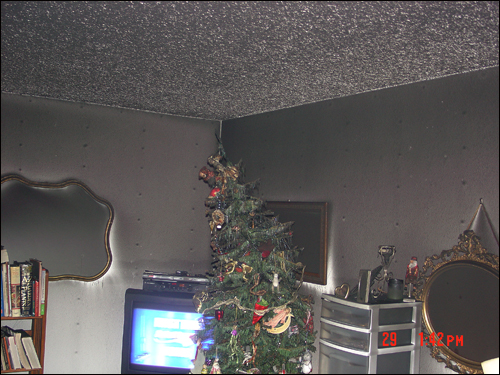
Note: Gresham Fire & Emergency Services Photo
Why didn’t this fire reach flashover? The fire occurred in early winter and the apartment’s energy efficient windows and doors were tightly closed. The developing fire consumed the oxygen available within the apartment and absent significant ventilation, decayed, and the temperature inside the apartment which had been increasing as the fire developed, dropped to a temperature slightly higher than would normally be expected inside an occupied apartment.
How might the development of this fire been different if it had been discovered earlier? What if a neighbor had opened a door or window in an effort to rescue the occupant? What if the fire department had opened the door without recognizing that the fire was significantly ventilation controlled?
When fire development is limited by the ventilation profile of the compartment, changes in ventilation will directly influence fire behavior. Reducing ventilation (i.e. by closing a door) will reduce the rate of heat release and slow fire development. Increasing ventilation (i.e. by opening a door or window) will increase the rate of heat release and speed fire development. Changes in ventilation profile may be fire caused (failure of glass in a window), occupants (leaving a door open), or tactical action by firefighters; but all will have an influence on fire behavior!
Figure 5. Ventilation Induced Flashover
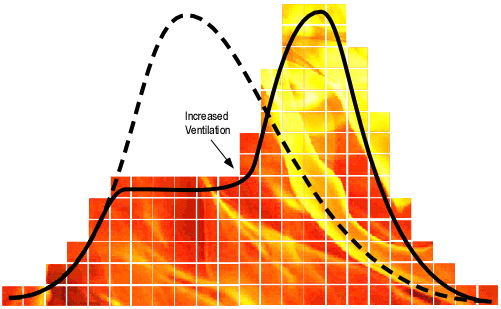
For many years firefighters have been taught that ventilation reduces the potential for flashover. While this is sometimes true, it is only part of the story. Increasing ventilation to a fuel controlled fire will allow hot gases to exit, transferring thermal energy out of the compartment and replacing the hot gases with cooler air (which increases heat release rate). The combined influence of these two factors slows progression towards flashover and increases the heat release rate required to reach flashover. The bathtub analogy presented in Understanding Flashover: Myths and Misconceptions [LINK], does not apply in this case, because when a fire is ventilation controlled, heat release rate is limited by the available oxygen. Under ventilation controlled conditions; increasing air supply by creating opening results in increased heat release rate. This increased heat release rate may result in flashover (see Figure 5). For more information see Hazards of Ventilation Controlled Fires.
Two Paths to Flashover
With adequate fuel and oxygen, a growth stage compartment fire may flashover and rapidly transition to the fully developed stage. Given adequate fuel, but lacking adequate oxygen (due to limited ventilation), a growth stage compartment fire may begin to decay before becoming fully developed. However, this can quickly change if ventilation is increased, potentially resulting in ventilation induced flashover.
Understanding these two paths to flashover is essential, but still does not provide a complete picture of the flashover phenomena. The next post in this series will will use several case studies to examine the influence of air track on flashover in multiple compartments the threat that rapid fire progression presents to firefighters.
Ed Hartin, MS, EFO, MIFIreE, CFO
References
Karlsson, B. & Quintiere, J. (2000). Enclosure fire dynamics. New York: CRC Press.
National Institute of Standards and Technology. (2005). ISO-room/living room flashover [digital video disk]. Gaithersburg, MD: Author.
Thornton, W. (1917). The relation of oxygen to the heat of combustion of organic compounds. The Philosophical Magazine,33(6), 196-203.
Parker, W. (1977). An investigation of the Fire Environment in the ASTM E 84 Tunnel Test, NBS Technical Note945. Gaithersburg, MD: U.S. Department of Commerce/National Bureau of Standards.
International Association of Arson Investigators (IAAI). (2009). Post flashover fires. On-Line Training Program, Downloaded August 6, 2009 from http://www.cfitrainer.net.
Tags: burning regime, Extreme Fire Behavior, fire behavior, fire development, flashover, NIST, practical fire dynamics, vent controlled fire



August 31st, 2009 at 21:14
Bonjour, je veux Donner ma version d’embrasement général de l’ONU Comme je l’ai vu Et comme je le connais.
Un embrasement est général de l’ONU feu complet en lui-même Qui Plusieurs Comprend étapesde consécutives suivis,
Un feu débute RAPIDEMENT Et tous les éléments de la chimie du feu Sont en action Dans ce Processus La Flamme est Rendue à environ 16 à 20 pouces et tous les matériaux combustibles autour de L’Origine du feu Sont impliqués et le dégagement des gaz de pyrolyse SE DEVELOPPE RAPIDEMENT, plus les gaz de combustion par Depasse Sont Les gaz de pyrolyse Qui vont s, au plafond Accumuler, (Il Faut Que retenir le local C Puisse, es gaz et cette chaleur au plafond c intense, est la condition pour pouvoir faire pricipale L’Embrasement général de L’ONU) ls est tellement flamme vive et intense que presque tous les gaz et le Corbon de la fumée tous brûler presque Sont, Le début d’un embrasement général il N’y Un pas de fumée ou rétroaction presque.La de thermique de rayonnement vers le sol du plafond sur tous les combustibles davaNtage fait Dégager de Gaz de pyrolyse Et tout cet ensemble de chaleur et de flamme accentu l’intensitt de chaleur et à un certain moment, le feu commence à manquer d «De l’air sur les perçois de la fumée Qui embrouille les Lieux et c, est à ce moment que les rouleaux de
Rollover flammes apparaissent, ensuite les langues de feu (Anges danse) sporadiques et La Fumée OCCUPE plus de place Dans le local manque le Feu d’air de plus en plus la fumée emplie le local et le peu appercevoir de petites langues de feu très sporadiqes Espaces ornage (scintille, capt du feu atlétique club) est entièrement contrôlé par le local La fumée dense. Il YA une entrée d’air violente et bruyante Qui provoquer un vide tellement Louverture devant c de l’entrée, est surprenant il ya un temps mort temps de mélange de gaz LII et il ya un Premier Ministre Backdraft de diamètre 3 à 4 mètres et Sur Une distance de 5 à 6 m `etres en distance je le nomme contenu voiture plus près du bâtiment ce backdraft Premier ministre a un Causé Regardez l’entrée devant et l, arrivée d’air frais à nouveau pour se mélanger en partie basse et au-feu de diluer la convection par les LSI en hauteur de là la plus grande force de pression d, omnde de choc pour ce volume Déplacer Grand De flammes Sur Une distance de 6 à 8 mètres, La Le embrasement général est complet, MAIS IL Encore a toutes les conditions pour Recommencer si rien n, est fait pour l’S’il N’y Arrêter ou Une Ingérence Aucune en l’air, en eau, pompiers etc,
C, est ce que j’appelle biavor extrême d’incendie, est rapide »C ‘et violent, entre 5 à 10 minutes d, Autre Bout de l’ONU à l’, Voir le vidéo du magasin LIDL c’est complet Embrasement Le Général de L’ONU, spécial, et très rares, et plus inabituel provoquer Une violente du contenu combustibles Probablement, IL EST Dans le conteneur Et dans la corniche et le mur, mais à partir de ce Que l’on voit la flèche Blance Remarquer Indique le retour vers l’intérieur, La Différence Dans Sule il se répand tout l’entretoit intérieur et vers le plafond.
J’ai tout Donné les documents en anglais AM, Ed Hartin complet Un embrasement c, est un feu complet en lui-même et par lui-même.Il lui Faut Conditions des Spécials bien pour éclore et éclater.
August 31st, 2009 at 21:23
J’ai écris ma version en bon français et cette traduction française,en français est très mal interprétée
Donner moi une adresse et je vous fait parvenir le texte en français beaucoup mieux que ce dernier.embrasement généralisé éclair.J’aime mieux juste dire flashover, les français emploie juste flashover maintenant
il manque le deuxième backdraft mélange des gaz (LSI)
September 8th, 2009 at 16:47
Hello
Brad McDonald,Fire Investigator, Calgary Fire Department.
Scenerio: One deceased
Three story walk up concrete construction. Fire top floor 600sqft one bedroom apartment. Deceased, smoker, medicated, elder lady on oxygen.
Sofa (full size, older sofa thick foam backing and seat)fire fed by O2 consumes couch and papers on couch clothing on couch cracks sliding glass door glass 3 ft away, melts top of tv (slightly) on opposite side of room. Excellent patterns lead point of origin to couch (slightly off center) next to deceased. Know here’s the kicker: two windows in apartment are open 3/4 each producing approx; 8sqft combined opening to outside and fire self extinguishes?? suggestions? Theories? Cheers Brad McDonald Fire Investigator CFD, 403-804-9471
September 22nd, 2009 at 05:33
Brad, Sorry for the delay in responding to your question. This is an interesting puzzle! Could you provide a bit more information on the configuration of the apartment (compartmentation, location and height of the window openings, etc.) and evidence indicating the level of the smoke layer throughout the apartment? My first thought is that the fire developed quickly and the smoke layer dropped below the window openings. This would produce a bi-directional air track, but the opening would be predominantly be an exhaust, limiting the effective inlet size. Reduced inward air movement would limit heat release rate, possibly to the extent to preclude or slow profgression flashover (without some change in conditions). I am guessing that the fire self-extinguished (or substantively so) prior to the arrival of the fire department. Cheers, Ed
October 22nd, 2009 at 08:54
[…] a significant hazard as increased ventilation may result in a ventilation induced flashover (see Understanding Flashover: Myths & Misconceptions Part 2 and The Ventilation […]
April 18th, 2021 at 16:22
Oddly just found this reply 11years later. Lol
We concluded that the enriched O2 machine fed the fire to a point that as you stated above created an exhaust only use of the open windows and not a balanced exhaust/ air intake situation and when the O2 machine failed the fire was unable to adjust to the enriched O2 cut off. The ongoing fire event was unable to balance the openings to an intake / exhaust configuration and starved itself of breathing. Sorry didn’t see your response sooner.
Cheers
Brad McDonald
Brad.mcdonald@calgary.ca